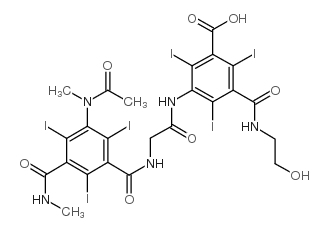ioxaglic acid

ioxaglic acid structure
|
Common Name | ioxaglic acid | ||
|---|---|---|---|---|
| CAS Number | 59017-64-0 | Molecular Weight | 1268.88000 | |
| Density | 2.545g/cm3 | Boiling Point | 887.9ºC at 760 mmHg | |
| Molecular Formula | C24H21I6N5O8 | Melting Point | 302°C | |
| MSDS | N/A | Flash Point | 490.8ºC | |
|
Computed tomography detects changes in contrast agent diffusion after collagen cross-linking typical to natural aging of articular cartilage.
Osteoarthr. Cartil. 19(10) , 1190-8, (2011) The effect of threose-induced collagen cross-linking on the mechanical and diffusive properties of cartilage was investigated in vitro. In particular, we investigated the potential of Contrast Enhanced Computed Tomography (CECT) to detect changes in articular... |
|
|
Hyperosmolaric contrast agents in cartilage tomography may expose cartilage to overload-induced cell death.
J. Biomech. 45(3) , 497-503, (2012) In clinical arthrographic examination, strong hypertonic contrast agents are injected directly into the joint space. This may reduce the stiffness of articular cartilage, which is further hypothesized to lead to overload-induced cell death. We investigated th... |
|
|
Acute thyrotoxicosis secondary to destructive thyroiditis associated with cardiac catheterization contrast dye.
Thyroid 21(4) , 443-9, (2011) Thyrotoxicosis caused by destructive thyroiditis is self-limited and results from the subacute release of preformed thyroid hormone. Common etiologies include painful subacute thyroiditis and silent (painless) subacute thyroiditis (including postpartum thyroi... |
|
|
The critical role of CT angiography in the detection and therapy of lower gastro-intestinal bleeding.
JBR-BTR 96(2) , 78-80, (2013) Lower gastro-intestinal bleeding (LGIB) is defined as a bleeding site localised in the colon or anorectum. (1) In the past, the diagnosis of LGIB has been a serious challenge for the radiology department because of its possible intermittent character, making ... |
|
|
A rare case of acute contrast-induced sialadenitis after percutaneous coronary intervention.
Isr. Med. Assoc. J. 15(10) , 652-3, (2013)
|
|
|
Contrast enhanced CT attenuation correlates with the GAG content of bovine meniscus.
J. Orthop. Res. 31(11) , 1765-71, (2013) We determined whether contrast-enhanced computed tomography (CECT) attenuation obtained using a µCT scanner correlated with the glycosaminoglycan (GAG) content and distribution in ex vivo bovine menisci. Bovine samples were immersed in different concentration... |
|
|
Impact of anticoagulation on ionic and nonionic contrast media effect on thrombogenesis and fibrinolysis: The PEPCIT study.
Catheter. Cardiovasc. Interv. 79(5) , 823-33, (2012) The effect of ionic low osmolar contrast media (ICM) and nonionic iso-osmolar CM (NICM) on acute thrombotic complications of percutaneous coronary intervention (PCI) is subject to controversies possibly related to a potential interaction with anticoagulation ... |
|
|
Incompatibility of contrast medium and trisodium citrate.
Cardiovasc. Intervent. Radiol. 36(1) , 237-8, (2013) To test the compatibility of trisodium citrate, a catheter lock solution, with iodinated contrast medium.Iohexol, iobitridol, iodixanol, ioxaglate, ioxithalamate, iomeprol, and iopromide were tested. In all tests, 2 ml of contrast medium were mixed with 2 ml ... |
|
|
Intrarenal application of N-acetylcysteine for the prevention of contrast medium-induced nephropathy in primary angioplasty.
Coron. Artery Dis. 23(4) , 265-70, (2012) Contrast medium-induced nephropathy (CIN) is a well-known complication of coronary angiographic procedures, especially in patients treated with primary angioplasty. To prevent CIN, we examined using a local application of N-acetylcysteine (NAC) for the preven... |
|
|
Retention of iodinated contrast material within renal cysts in a patient with autosomal dominant polycystic kidney disease.
Br. J. Radiol. 85(1011) , e53-5, (2012) Hyperdense renal cysts, a common condition in autosomal dominant polycystic kidney disease, may be induced by haemorrhage into the cysts. However, hyperdense renal cysts resulting from retention of contrast material after intravenous injection is extremely un... |